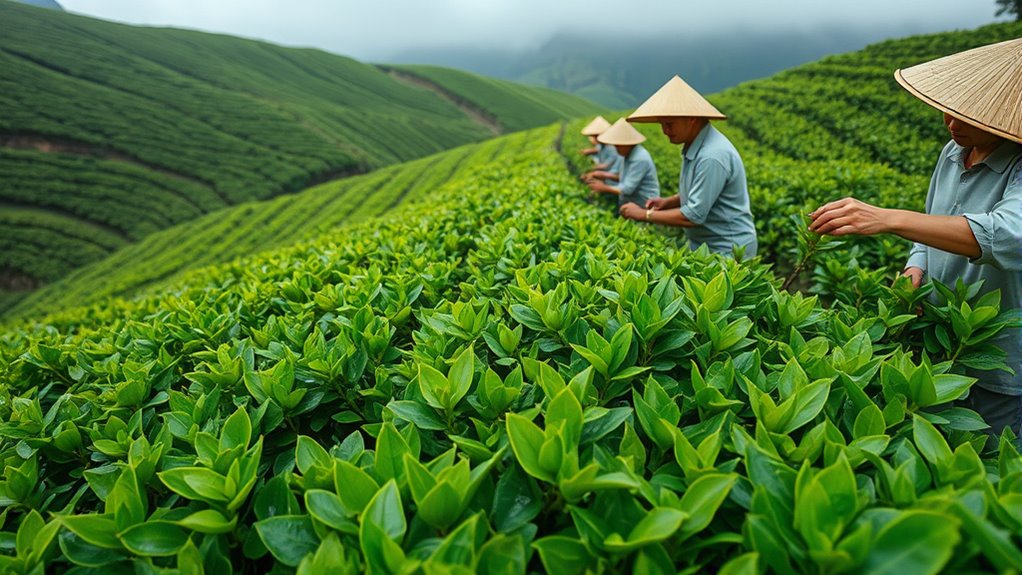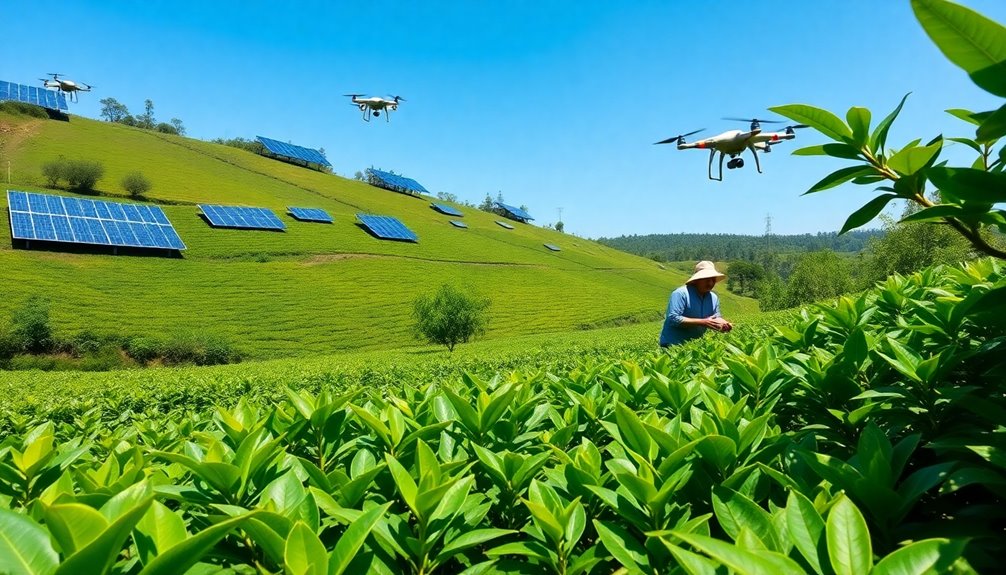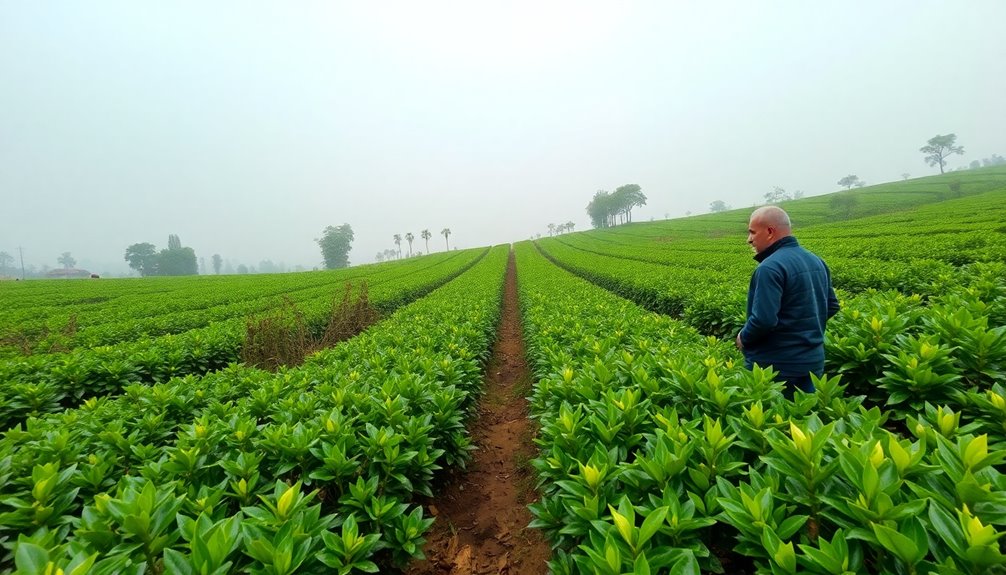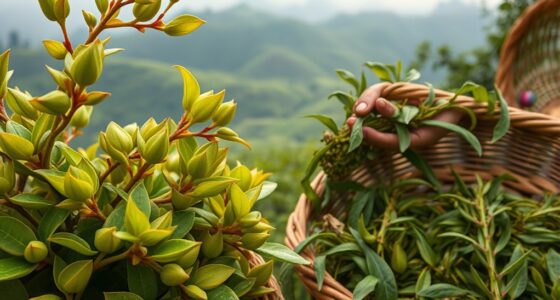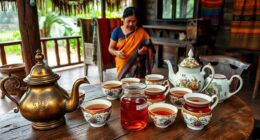In exploring case studies of tea production and harvesting, you’ll see how traditional methods like hand plucking in regions like Darjeeling and Assam emphasize skill and craftsmanship, ensuring high-quality leaves. You’ll learn how different processing techniques—such as oxidation for black tea or steaming for green tea—are influenced by regional climates, shaping flavor profiles. Recognizing the role of fermentation and environmental factors reveals the artistry behind each brew. Continue discovering how these practices combine science and tradition to produce exceptional teas.
Key Takeaways
- Examining regional plucking techniques highlights differences in hand harvesting versus mechanical methods.
- Analyzing processing methods reveals how oxidation and heating influence tea types and quality.
- Case studies demonstrate climate’s impact on fermentation, drying, and flavor development in various regions.
- Comparing traditional craftsmanship with industrial practices shows effects on tea aroma, appearance, and overall quality.
- Insights into specific tea plantations illustrate best practices for sustainable, high-quality production and harvesting.
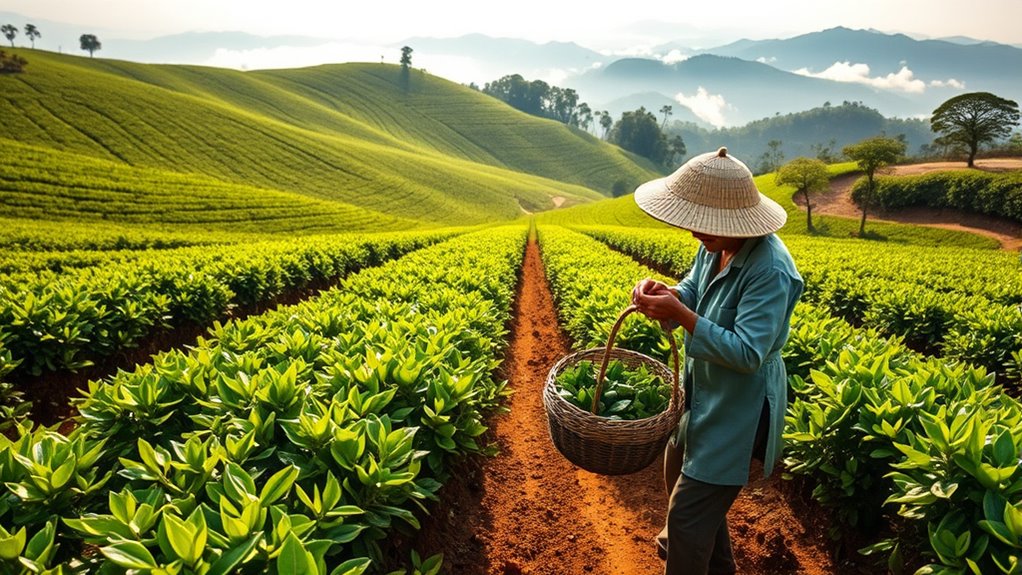
Tea production and harvesting vary considerably across different regions, reflecting unique agricultural practices, climate conditions, and cultural traditions. When you’re involved in tea cultivation, you quickly realize that how you pluck tea leaves plays a vital role in determining the quality of the final product. Most tea farmers focus on tea leaf plucking, which involves carefully selecting the right leaves—typically the tender top buds and a few young leaves beneath. This selective process demands skill and attention to detail, as plucking too many leaves or choosing the wrong ones can affect flavor and aroma. In regions like Darjeeling or Assam, plucking is often done by hand to guarantee only the best leaves are harvested, preserving the delicate balance that produces high-quality tea. Conversely, some large-scale plantations may use mechanical harvesters, but these often sacrifice precision for speed, sometimes resulting in mixed leaf quality.
Once the leaves are plucked, processing techniques come into play, transforming fresh leaves into the diverse range of teas you’re familiar with—green, black, oolong, or white. The processing methods vary based on the type of tea being produced. For instance, black tea involves full oxidation, where the leaves are withered, rolled, and then fermented before drying. This process develops the rich, bold flavors you associate with classic black teas. Green tea, on the other hand, skips the fermentation step; the leaves are quickly heated through pan-firing or steaming to halt oxidation, preserving the vibrant green color and fresh, grassy notes. Oolong tea falls somewhere in between, with partial oxidation that creates complex flavors. White tea, typically made from young leaves and buds, undergoes minimal processing—often just withering and drying—resulting in a delicate, subtle profile.
The choice of processing techniques is deeply rooted in regional traditions and climate factors. In warmer, humid areas, natural fermentation processes might be faster, while in cooler regions, extra steps are taken to guarantee proper oxidation and drying. These variations influence the taste, aroma, and appearance of the final product. Additionally, the fermentation process plays a crucial role in developing the flavor profiles of different teas, highlighting the importance of controlled conditions during processing. As a tea producer or enthusiast, understanding these distinctions helps you appreciate the craftsmanship behind each cup. Whether it’s the meticulous hand plucking in small farms or the precise control over fermentation and drying in industrial settings, each step reflects centuries of tradition and adaptation. Your enjoyment of tea is therefore rooted in these carefully executed practices, highlighting the artistry behind each harvest and processing technique.
Frequently Asked Questions
What Are the Environmental Impacts of Tea Harvesting Methods?
You should know that tea harvesting methods can harm the environment by causing soil degradation and water pollution. Mechanical harvesting, while efficient, can disturb the soil and reduce its fertility over time. Additionally, the use of chemicals and improper waste disposal may lead to water pollution, affecting local ecosystems. To minimize these impacts, adopting sustainable practices like organic farming and careful waste management is essential.
How Does Climate Change Affect Tea Crop Yields?
You might notice that climate change directly impacts tea crop yields by increasing temperatures and causing unpredictable weather patterns. As droughts become more frequent, your tea plants struggle with water stress, reducing harvests. To adapt, farmers focus on climate adaptation strategies and enhancing drought resilience, ensuring they can sustain yields despite these challenges. Staying proactive helps protect your tea supply and supports a resilient, thriving crop even amid changing climate conditions.
What Traditional Harvesting Techniques Are Still Used Today?
You still use traditional harvesting techniques like hand plucking, where you carefully select only the tender leaves and buds to make certain of quality. You also rely on traditional pruning methods, which involve trimming the tea bushes to promote healthy growth and better yields. These techniques maintain the tea’s quality and flavor, preserving the cultural heritage of tea cultivation while allowing you to harvest efficiently and sustainably.
How Do Tea Farmers Manage Pest Control Sustainably?
You manage pest control sustainably by adopting integrated pest management, which combines biological, cultural, and mechanical methods to reduce chemical use. You also aim for organic certification, avoiding synthetic pesticides entirely. This approach helps protect your tea plants and the environment, ensuring your harvest remains eco-friendly and healthy. By monitoring pests carefully and using natural solutions, you maintain a balanced ecosystem and meet consumer demand for organic, sustainable tea.
What Are the Economic Challenges Faced by Small-Scale Tea Producers?
You face economic challenges like limited market access, unpredictable price volatility, and rising production costs. These issues make it hard to plan your income, secure fair prices, and invest in quality improvements. You might struggle to compete with larger producers and reach international markets. To succeed, you need strategies that improve market access, stabilize prices, and reduce costs, helping you build resilience and sustain your tea farming operations.
Conclusion
As you walk through lush green tea plantations, you see workers carefully plucking tender leaves, their hands swift and sure. The aroma of fresh tea leaves fills the air, mingling with the gentle rustle of leaves in the breeze. Each step in production transforms these vibrant leaves into a warm, comforting cup. Remember, behind every sip lies a story of dedication, tradition, and nature’s beauty, waiting to be savored with every calming sip you take.

